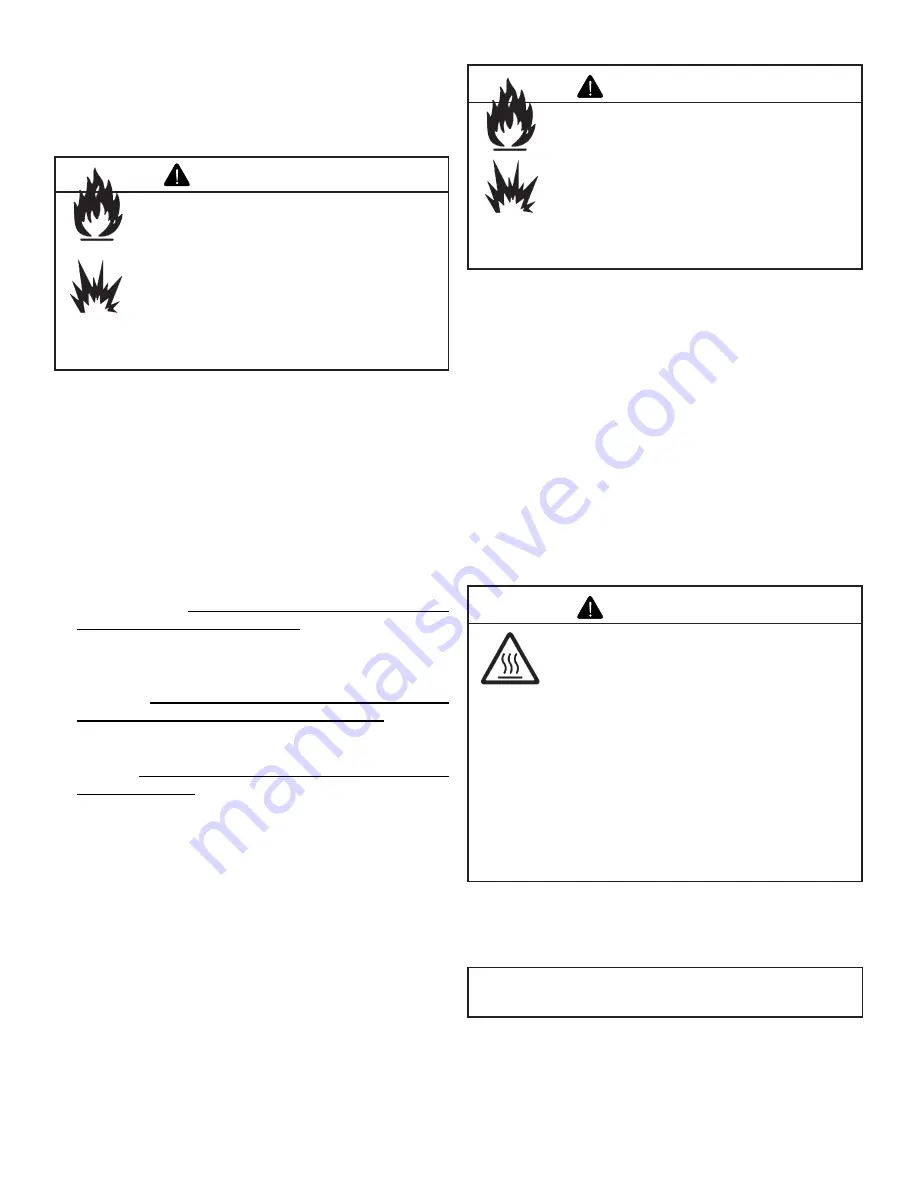
4
Firegear, LLC., -IM-138 2/2012
F. Gas Pressure
Proper input pressures are required for optimum appliance
performance. Gas line sizing requirements need to be made
following
NFPA51
.
Fire Risk
Explosion Risk
Verify inlet pressures.
• High pressure may cause over fire
condition.
• Low pressure may cause explosion.
Install regulator upstream of valve if line
pressure is greater than /2 psig.
WARNING
Fire Risk
Explosion Risk
High pressure will damage valve.
• Disconnect gas supply piping BEFORE
pressure testing gas line at test pressures
above /2 psig.
• Close the manual shutoff valve BEFORE
pressure testing gas line at test pressures
equal to or less than /2 psig.
WARNING
• Gas Supply Pressure: Minimum inlet gas supply pressure
must be 7.0 in. W.C. for natural gas. The gas line
supplying the appliance must be sufficient size to furnish
the appropriate supply pressure to the appliance while
operating in the “High” setting.
• Pressure tap screws must be closed before turning gas
on to the appliance.
• Gas Line Pressure Test: Perform pressure test according
to state and local code (if pressure exceeds /2 in. psi (3.5
kPa)) before appliance is connected. Be sure to release
air pressure from the gas line before connection is made
to the appliance. Excessive pressure will damage the gas
control and may cause a gas leak.
• Gas Leak Test: Make sure the gas connections are tight.
Turn on the gas and coat each joint with a non-corrosive
gas leak check solution. Air bubbles will form indicating
any leaks. DO NOT USE A FLAME OR ANY TYPE OF
IGNITION SOURCE TO CHECK FOR LEAKS. All leaks
must be corrected before proceeding with installation.
• The appliance must only be installed in a solid-fuel burning
fireplace with the flue damper clamped open according
to Tables and 2. The fireplace must be constructed of
non-combustible material.
• The minimum permanent free opening (in square inches)
that must be provided by the fireplace chimney or damper
to vent the flue gases is provided in Tables and 2. If the
free opening is smaller than the specified area, do not use
this appliance.
• The damper must be removed or fixed in a manner in
which will secure it open. Some jurisdictions require the
damper to be removed or permanently welded fully open.
Check with state and local codes.
• Be sure that the chimney is completely unobstructed to
ensure proper ventilation of flue gases including carbon
monoxide (CO). CO (a poisonous gas) is tasteless,
odorless, colorless and undetectable without proper
equipment.
• Refer to Table 3 to determine minimum fireplace opening
requirements before proceeding.
Asphyxiation Risk
This appliance produces carbon monoxide
(CO).
• The free opening areas (in square inches)
of the chimney damper as shown in the
following tables must be met.
• User must make sure damper is locked
open.
• The installer is responsible to ensure
proper ventilation of flue gases before
appliance is used.
Fire needs to draft properly for safe
operation.
WARNING
G. Negative Pressure
Negative pressure results from the imbalance of air avail-
able for the fireplace to operate properly. Causes for this
imbalance include:
• Exhaust fans (kitchen, bath, etc.).
• Range hoods.
• Combustion air requirements for furnaces, water heaters
and other combustion appliances.
• Clothes dryers.
• Location of return-air vents to furnace or air
conditioning.
• Imbalances of the HVAC air handling system.
• Upper level air leaks: recessed lighting, attic hatch
opening, duct leaks.
Note:
Log placement photos and instructions are located
in the log packages.




























